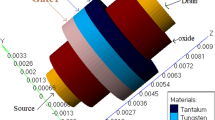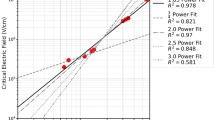Abstract
Field-effect devices based on SiC metal-oxide-semiconductor (MOS) structures are attractive for electronic and sensing applications above 250°C. The MOS device operation in chemically corrosive, high-temperature environments places stringent demands on the stability of the insulating dielectric and the constituent interfaces within the structure. The primary mode of oxide breakdown under these conditions is attributed to electron injection from the substrate. The reliability of n-type SiC MOS devices was investigated by monitoring the gate-leakage current as a function of temperature. We find current densities below 17 nA/cm2 and 3 nA/cm2 at electric field strengths up to 0.6 MV/cm and temperatures of 330°C and 180°C, respectively. These are promising results for high-temperature operation, because the optimum bias point for SiC MOS gas sensors in near midgap, where the field across the oxide is small. Our results are valid for n-type SiC MOS sensors in general and have been observed in both the 4H and 6H polytypes.
Similar content being viewed by others
References
H. Morkoç, S. Strite, G.B. Gao, M.E. Lin, B. Sverdlov, and M. Burns, J. Appl. Phys. 76, 1363 (1994).
A.L. Spetz et al., Phys. Status Solidi A 185, 15 (2001).
P. Tobias, S. Ejakov, B. Golding, and R.N. Ghosh, IEEE Sensors J. 3, 543 (2003).
L.A. Lipkin and J.W. Palmour, J. Electron. Mater. 25, 909 (1996).
P. Tobias, B. Golding, and R.N. Ghosh, Proc. Transducers 2003 1, 416 (2003).
Model 90-I-V Characterization System and Model 82-WIN Simultaneous C-V System, Keithley Instruments, Inc., Cleveland, OH.
R.N. Ghosh, P. Tobias, S.G. Ejakov, and B. Golding, Proc. IEEE Sensors 2, (2002).
R.N. Ghosh, P. Tobias and B. Golding, Mater. Res. Soc. Symp. Proc. 742, 363 (2003).
M.M. Maranowski and J.A. Cooper, Jr., IEEE Trans. Electron. Dev. 46, 520 (1999).
S. Dimitrijev and P. Jamet, Micro. Reliab. 43, 225 (2003).
V.V. Afanas’ev, M. Bassler, G. Pensl, and M.J. Schulz, J. Appl. Phys. 79, 3107 (1996).
M.K. Das, Mater. Sci. Forum 457–460, 1275 (2004).
J. Senzaki, M. Goto, K. Kojima, K. Yamabe, and K. Fukuda, Mater. Sci. Forum 457–460, 1269 (2004).
G.Y. Chung, C.C. Tin, J.R. Williams, K. McDonald, M. Di Ventra, S.T. Pantelides, L.C. Feldman, and R.A. Weller, Appl. Phys. Lett. 76, 1713 (2000)
X.W. Wang, Z.J. Luo, and T.P. Ma, IEEE Trans. Electron Dev. 47, 458 (2000).
Author information
Authors and Affiliations
Rights and permissions
About this article
Cite this article
Ghosh, R.N., Tobias, P. SiC field-effect devices operating at high temperature. J. Electron. Mater. 34, 345–350 (2005). https://doi.org/10.1007/s11664-005-0108-3
Received:
Accepted:
Issue Date:
DOI: https://doi.org/10.1007/s11664-005-0108-3




